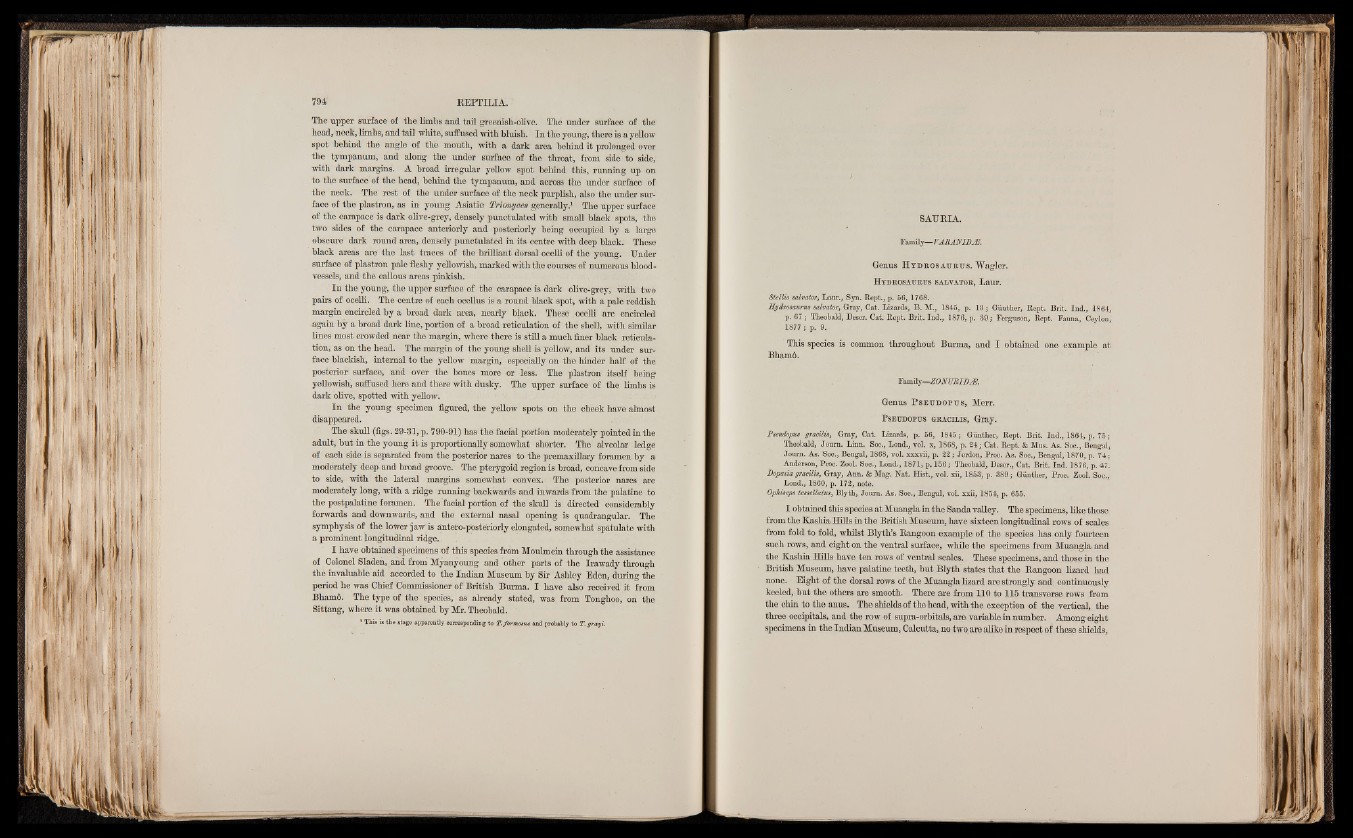
The upper surface of the limbs and tail greenish-olive. The under surface of the
head,'neck, limbs, and tail white, suffused with bluish. In the young, there is a yellow
spot behind the angle of the mouth, with a dark area behind it prolonged over
the tympanum, and along the under surface of the throat, from side to side,
with dark margins. A broad irregular yellow spot behind this, running up on
to the surface of the head, behind the tympanum, and across the under surface of
the neck. The rest of the under surface of the neck purplish, also the under surface
of the plastron, as in young Asiatic Trionyces generally.1 The upper surface
of the carapace is dark olive-grey, densely punctulated with small black spots, the
two sides of the carapace anteriorly and posteriorly being occupied by a large
obscure dark round area, densely punctulated in its centre with deep black. These
black areas are the last traces of the brilliant dorsal ocelli of the young. Under
surface of plastron pale fleshy yellowish, marked with the courses of numerous bloodvessels,
and the callous areas pinkish.
In the young, the upper surface of the carapace is dark olive-grey, with two
pairs of ocelli. The centre of each ocellus is a round black spot, with a pale reddish
margin encircled by a broad dark area, nearly black. These ocelli are encircled
again by a broad dark line, portion of a broad reticulation of the shell, with s im i l a r
lines most crowded near the margin, where there is still a much finer black reticulation,
as on the head. The margin of the young shell is yellow, and its under surface
blackish, internal to the yellow margin, especially on the hinder ha.lf 0f the
posterior surface, and over the bones more or less. The plastron itself being
yellowish, suffused here and there with dusky. The upper surface of the limbs is
dark olive, spotted with yellow.
In the young specimen figured, the yellow spots on the cheek have almost
disappeared.
The skull (figs. 29-31, p. 790-91) has the facial portion liioderately pointed in the
adult, but in the young it is proportionally somewhat shorter. The alveolar ledge
of each side is separated from the posterior nares to the premaxillary foramen by a
moderately deep and broad groove. The pterygoid region is broad, concave from side
to side, with the lateral margins somewhat convex. The posterior nares are
moderately long, with a ridge running backwards and inwards from the palatine to
the postpalatine foramen. The facial portion of the skull is directed considerably
forwards and downwards, and the external nasal opening is quadrangular. The
symphysis of the lower jaw is antero-posteriorly elongated, somewhat spatulate with
a prominent longitudinal ridge..
I have obtained specimens of this species from Moulmein through the assistance
of Colonel Sladen, and from Myanyoung and other parts of the Irawady through
the invaluable aid accorded to the Indian Museum by Sir Ashley Eden, during the
period he was Chief Commissioner of British Burma. I have also received it from
Bham6. The type of the species, as already stated, was from Tonghoo, on the
Sittang, where it was obtained by Mr. Theobald.
* This is the stage apparently corresponding to T.formosus and probably to T. grayi.
SAUBIA.
Family— VARANIDÆ.
Genus H y d r o s a t j r t j s . Wagler.
H y d b .osatjb.tjs sa l v a t o r , Laur.
Stellio salvator, Laur., Syn. Rept., p . 56, 1768.
Hydrosawus salvator, Gray, Cat. Lizards, B . M., 1845, p. 18 ; Günther, Rept. B rit. In d ., 1864,
p. 6 7 ; Theobald, Deser. Cat. Rept. B rit. In d ., 1876, p. 8 9 ; Ferguson, Rept. Fauna, Ceylon,
1877 ; p. 9.
This species is common throughout Burma, and I obtained one example at
Bhamô.
Family—Z0NURIDÆ.
Genus P s e t j d o p t j s , Merr.
P se tjdoptjs g r a c i l i s , Gray.
Pseudopus gracilis, Gray, Cat. Lizards, p. 56, 1845 ; Günther, Rept. B rit. In d ., 1864, p . 75 ;
Theobald, Jo u rn . Linn. Soc., Lond., vol. x, 1868, p. 24 ; Cat. Rept. & Mus. As. Soc., Bengal,
Jo u rn . As. S o g ., Bengal, 1868, vol. xxxvii, p . 22 ; Jerdon, Proc. As. Soc., Bengal, 1870, p . 7 4 ;
Anderson, Proc. Zool. Soc., Lond., 1871, p . 156 ; Theobald, Descr., Cat. B rit. In d . 1876, p. 47.
Dopasia gracilis, Gray, Ann. & Mag. N a t. H is t., vol. xii, 1853, p.. 3 8 9 ; Günther, Proc. Zool. Soc.,
Lond., 1860, p. 172, note.
Ophiseps tessellatus, B ly th , Journ. As. Soc., Bengal, vol. xxii, 1854, p . 655.
I obtained this species at Muangla in the Sanda valley. The specimens, like those
from the Kashia Hills in the British Museum, have sixteen longitudinal rows of scales
from fold to fold, whilst Blyth’s Rangoon example of the species has only fourteen
such rows, and eight on the ventral surface, while the specimens from Muangla and
the Kashia EQlls have ten rows of ventral scales. These specimens, and those in the
British Museum, have palatine teeth, but Blyth states that the Rangoon lizard had
none. Eight of the dorsal rows of the Muangla lizard are strongly and continuously
keeled, but the others are smooth. There are from 110 to 115 transverse rows from
the chin to the anus. Thé shields of the head, with the exception of the vertical, the
three occipitals, and the row of supra-orbitals, are variable in number. Among eight
specimens in the Indian Museum, Calcutta, no two are alike in respect of these shields,